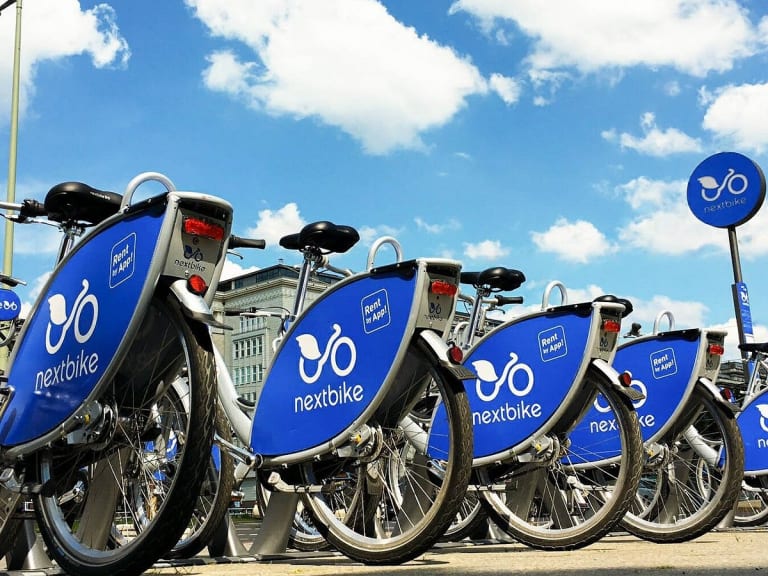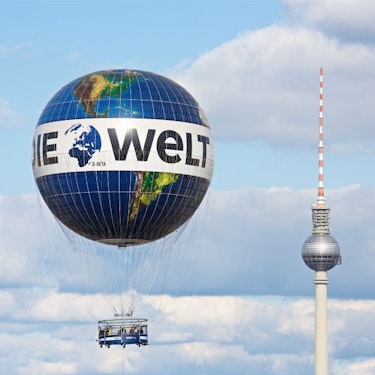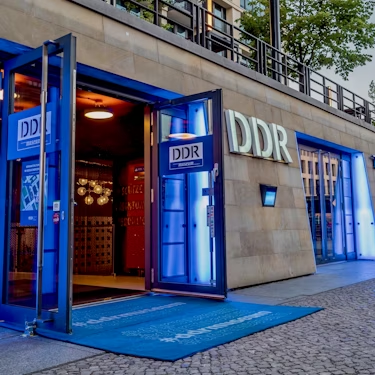More about: Berlin Bike Tours
Thanks to the almost total absence of hills, the German capital is perfect for getting around by bicycle. The best thing is that not only can the city's inhabitants take advantage of this aspect, but visitors can also tour and see all of Berlin's attractions using this mode of transport.
The various guided bike tours offered in the city are designed so that anyone can do them, regardless of age or fitness level. Despite Berlin's traffic, the tours are easy to complete and there are plenty of stops to take in the sights along the way.
The best of Berlin in a small group

This approximately three-and-a-half-hour tour of Berlin is an ideal way to get a first taste of the city's main attractions. Accompanied by an expert guide, you will receive information about everything you see along the way.
The tour takes advantage of part of the almost 620 kilometres of bicycle lanes that run through the German capital, making it one of the most comfortable places on the continent to use this means of transport.
Thanks to the tour, you'll get an unbeatable introduction to Berlin's extensive and interesting history. Moreover, it is a tour that does not focus on a single topic, but offers a very complete perspective on everything related to the German city.
What is the usual itinerary for this type of tour?
- Berlin Kulturbrauerei: a very interesting example of the city's industrial architecture from the late 19th century.
- Berlin Wall Memorial: a reminder of the wall that divided the city for decades and a tribute to the deaths of those who tried to cross it.
- Brandenburg Gate: one of the symbols of the city and is located on Pariser Platz. It is therefore one of the must-see monuments in the centre of Berlin.
- Reichstag: the seat of the Lower House of the German Parliament since 1999. If you visit it later on foot, I recommend you to go up to its dome to enjoy incredible views. Here you have information about tickets
- Holocaust Memorial: monument to remember the 6 million Jews who were murdered by the Nazis. One of the city's must-see sights.
- Tiergarten: beautiful park where the Berlin Zoo is located (a great visit if you have been to the city with children) and the Victory Column.
- Checkpoint Charlie: one of the symbols of the Cold War. This is where one of the crossroads between West and East Berlin was located. You may be familiar with it because it has been mentioned in a lot of spy movies.
- Gendarmenmarkt: for many, the most beautiful square in the city. If you have travelled to Berlin at Christmas time, here you will find one of the most important Christmas markets.
- Museum Island: this area is home to some of the most important museums in Berlin. Stay well with the area, as a visit to the Museum Island is a must if you are in the city.
- Berlin Cathedral: a beautiful Protestant church.
Recommended if... you like cycling and want to get a first impression of the city and then visit it at your leisure.
Historical Berlin Bike Tour: soak up the fascinating history of the city.

Berlin's history is perfectly reflected in its streets. Despite being largely destroyed in the Second World War, the reconstructions and what remains standing, as well as the new memorial buildings, give you a good insight into the city's past on this bike tour.
For three and a half hours, the guide accompanying your small group of cyclists will give you an insight into the main events that took place at each location along the route. During the tour, you'll see everything from Berlin' s Prussian heritage to its more recent history, including the ravages of the Nazi Third Reich and the remnants of the Cold War.
These types of historical tours usually follow a similar itinerary to the following
- St. Nicholas Church: The Nikolaikirche has been one of Berlin's landmarks for over 800 years.
- New Jewish Synagogue: this religious temple will help you learn more about the history of the Jews in the city.
- Berlin Wall Memorial: this place remains as a reminder of the division of Germany during the Cold War. Here you will be able to see the last remains of the wall and, behind it, some land on which border fortifications were erected in the 1980s. With the explanations of your guide you will be able to get to know a little better this fundamental part of the history of the whole world during the 20th century.
- Reichstag: historically speaking, the current seat of the Lower House of Parliament once housed the government of the Weimar Republic in the interwar period. In 1933 it was taken over by the Nazis and its burning is a fundamental part of their rise to power.
- Brandenburg Gate: built in the 18th century, this monument is one of the most important in the German capital.
- Holocaust Memorial: your bike ride will stop at Berlin's most important monument, which commemorates the Jews murdered by the Nazis.
- Former Gestapo headquarters: the so-called Topography of Terror was the headquarters of the Nazi secret police, the Gestapo. Today the site is home to a museum that recounts the atrocities committed by this police force.
- Checkpoint Charlie: one of the main border crossings in divided Berlin after World War II.
- Memorial at Bebelplatz: its fame is due to the fact that it was one of the places where banned books were burned by the Nazis.
- Museum Island: the group will tour the island to learn about the museums and their history.
Recommended if... you are passionate about history and want an expert guide to give you the most important facts about it.
Discover some of Berlin's most alternative neighbourhoods.

For many years, Berlin had a reputation as a city with a very alternative atmosphere. You can still see it today in many of the city's nightlife venues, as well as in many of the neighbourhoods you should visit. This bike tour leaves the centre of Berlin for a three-and-a-half hour ride through some of these areas.
These tours usually start in Prenzlauer Berg and go through various areas along the river Spree. The most interesting part of the tour is the Kreuzberg district and its alternative culture.
Typical itinerary for a tour of alternative Berlin
- Kulturbrauerei buildings: these buildings started out as the headquarters of a brewery. In addition to their architectural value, their importance today is due to their function as the cultural centre of the Kollwitz district.
- Volkspark Friedrichshain: the oldest park in the city and a place where many Berliners come to relax on the grass.
- Friedrichshain: after reunification, this area became one of Berlin's centres of alternative culture. Many artists, students, and punks gathered here, creating a neighbourhood with a different personality from the rest of the city.
- Boxhagener Platz and the RAW Tempel: if you want to enjoy Berlin's nightlife afterwards, make a note of these areas, as they are some of the most atmospheric in the city.
- East Side Gallery: without a doubt, one of the points on the itinerary that you are going to like the most. Located next to the river, it is considered to be the largest open-air art gallery in the world. In its almost one and a half kilometre extension you will be able to see some of the remains of the Berlin Wall that were decorated by different artists after its fall.
- Kreuzberg: the entire Kreuzberg district is worth a visit, from the backyards to the parks. The colourful SO36 district is a particular highlight, where alternative lifestyles are still very much alive and kicking.
Recommended if... you like to discover the less touristy parts of the city and explore the more alternative neighbourhoods.
Rent a bike and organise your own tour

One option for cycling tours is to simply rent a bike and create your own itinerary. Although you'll be riding without a guide and you might get lost at some point, Berlin is a very suitable city for this activity.
If you're in good shape, you won't be limited to just walking the streets of the capital, and you'll be able to take a short trip to the surrounding area without too much effort.
There are several routes recommended by the city's own tourist authorities. Here are just a couple of examples, but if you do some research I have no doubt you'll find more.
- Cycle along the Spree: one of the most pleasant routes for cycling in Berlin's inner city is to follow the banks of the river Spree. It is a very quiet and comfortable route that will allow you to see the Museum Island and other monuments in Mitte.
- Walk through Tiergarten: although it is not a very long route, you can always imitate the many Berliners who take advantage of the arrival of good weather to cycle through this park. It is also a great way to get to Charlottenburg Palace and the surrounding neighbourhood.
Where to rent a bike if you want to go on your own
One of the advantages of Berlin for bike lovers is that you won't have any problems finding companies that rent bicycles. For your reference, here are just a few names:
- Nextbike: is a Bike Sharing project that allows you to use bicycles for free. Find out the conditions if you want to participate.
- Deutsche Bahn: their bicycle rental service is called Call a Bike. Just call to get all the information you need.
- Velotaxi: not strictly a bicycle rental company, but a kind of bicycle taxi. The best thing about it is that it is half the price of a normal taxi and that it fits two people (without luggage).
- Alex rent a bike: a fairly inexpensive bike rental company.
What is usually included in a Berlin bike tour?

To begin with, these bike tours have a guide with a double function: to make sure you don't get lost along the way and to explain everything you see. This is, in my opinion, what makes the difference between going on your own and doing it organised.
Of course, you will also be given your own bike so that you can do the tour. All of them meet the minimum requirements set by the city's legislation.
Moreover, many of them include the loan of a helmet (although it is not compulsory) and some other protective equipment. Last but not least, some tours also provide a poncho in case it rains.
Some tips for cycling in Berlin

It is always important to keep a few things in mind when cycling in an unfamiliar city. Berlin, although very bike-friendly, is no exception, so it's best to follow a few tips.
For starters, use the special bike lanes whenever possible. Luckily, most of the main streets have one, although you can ride either on the road or on the pavement, depending on the area.
A very positive aspect is that cars and buses are generally very respectful of cyclists in areas where there is no cycle lane. However, I would advise you to be very careful and not to be overconfident.
On the other hand, in the German capital you will benefit from the many signs that help cyclists to reach their destination or at least the most important places in the city.
The most basic safety rules include checking right and left turns and watching out for pedestrians. Helmets are not compulsory, but lights and brakes are mandatory. Of course, you must also obey the traffic lights, both special and general.
Cycling on the pavement is forbidden, as is talking on a mobile phone or listening to music with a headset.


















